
10 minute read
Aayushi Khillan Promoting SteM ways of thought
from 2023-05-Melbourne
by Indian Link
t he Indian-Australian medical student was handpicked from some 1000 national applications to drive change in the SteM field
BY L AKSHMI gANAPATHY
Twenty-two-year-old Aayushi Khillan has been chosen for a new Federal Government initiative aiming to engage youth in the policy-making process.
The Melbourne-based medical student is one of eight 16 to 25-year-olds from around Australia selected for the ‘Promotion of STEM’ Youth Advisory Group, who will work with the Government to boost STEM and related careers.

Aayushi Khillan is the founder of Body Buddies, a not-for-profit encouraging body literacy, and a board member of the Victorian Curriculum and Assessment Authority (VCAA).
She is an advocate for greater minority representation in STEM and says it’s something she’ll push for in Canberra.
“I’m passionate about health awareness and being a woman of colour in STEM; I’m wary there’s not a lot of people like me,” she says. “By the age of nine, the majority of women have decided not to go into STEM…there’s a lot of representation that must be done and I want to champion that.”
Meeting regularly over the next two years, the ‘Promotion of STEM’ group will work towards increasing diversity and building and retaining STEM talent within Australia.
They will work with the Department of Industry, Science and Resources and national science engagement centre Questacon to create an exhibition to engage and inform schools on the non-traditional careers available within STEM.
“Promoting non-traditional pathways within the STEM field is a big one, so people don’t think it’s limiting. Some people think ‘I’m not smart enough, I can’t go into it’, whereas there’s a lot of ways you’re involved in STEM without even realising,” she says.
Khillan is keen to go further and promote not only careers, but the importance of the STEM thought process.
“The problem solving and critical analysis skills that we learn from these subjects can be used in any aspect of life,” she says.
“I want to change the way we conceptualise STEM as just traditional pathways, to a way of thinking that we can apply to our everyday lives.”
The Youth Advisory Group and Office of Youth were recently reinstated by the Albanese Labor Government, after their abolishment in 2013 under the Abbott Liberal Government. This back-and-forth frustrates Khillan, who hopes the groups can have a lasting and continued impact.
“This youth voice is kind of oscillating; how can changes be made if there’s no stability on whether we’re included or not. I think that it’s a good step this government’s taking, but it will only be good if it’s enforced in the long term,” she says.
She says being assertive and holding Ministers to account is of vital importance to the program’s success.
“As soon as we got to our meeting with the Ministers, we said ‘We want to make sure our impact is long lasting.’ There is a bit of resistance, but as a young person and an advocate you have to be pushy,” says Khillan.“The Minister for Youth [Hon Anne Aly] said from day one: ‘You have to tell us off on what we’re doing wrong and what we can be doing’.”
Amidst surging rates of mental illness, cuts to higher education and the spiralling cost-of-living crisis, young people are feeling increasingly disempowered and marginalised.
According to Monash University’s Youth Barometer, 53% of young people expect to be financially worse off than their parents, and just under a quarter are pessimistic about having children themselves.
Aayushi Khillan notes the role of the pandemic in exacerbating youth disillusionment.
“Especially during COVID, there was a lot of separation between what young people were experiencing and what the government was doing about it… it’s a generational gap,” she says.“Everyone working in the government is so old, whereas we’re quite young – it’s like trying to talk to your parents.”
She advises young people who want to fight for change to grab whatever opportunity arises.
“When I was young, I would just get involved in any opportunity that came my way; the more experience you get speaking up, the more you will feel like your voice deserves to be heard, and that’s an important thing,” she says.
At the same time, Aayushi Khillan acknowledges the role of governments and organisations in making space for young people.
“It takes two to tango, and it involves the government and organisations giving us a platform to shine our voice,” she says.
“Young people need to take that power. I can already see that our generation is quite fierce with our views; whether it be good or bad, we’re confident in what we think. But it also involves the government changing too.”
When I arrived on Sydney Uni campus, I just couldn't believe myself. I had made it. A boy living in a Delhi slum had moved to Sydney University.
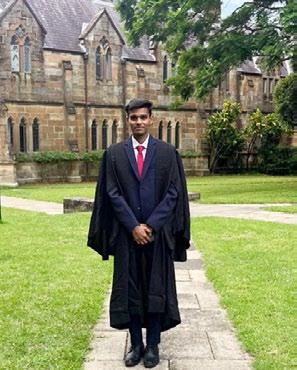
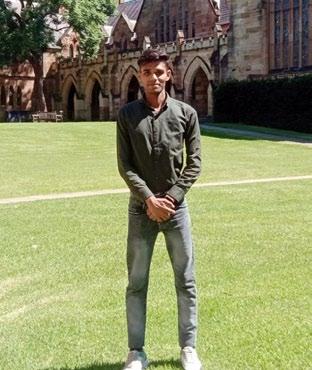

My first thought was, this is such an amazing place. I loved the big buildings and the traditional structures. I thought, it is just beautiful. This is what beauty is.
It was an amazing feeling.
Back in Delhi, preparing to come here to do my masters, there were apprehensions. Will I make friends, I wondered? I have so many friends here in India, but how will I make friends in Sydney? Would it be tough for me to adjust to the culture?
Today I can say I am very fortunate. I’m lucky to have got into St Paul's College, where everyone is so friendly, and the people are so loving. I'm enjoying my time here.
I’m studying public policy. I was not a very good student in my school until Year 10. I was a very average student. I liked science community. The reason is that my home is just next to an illegal liquor shop. So it was the right thinking on my parents’ part, that environment, that surrounding would have a negative impact on my personality, a bad influence on me.
So I didn't have many friends in my community. And there were so many other challenges as well. Like we don't have adequate water supply in the community. I remember when I was preparing for my final exams, I had to spend all night carting buckets for the next day, so we would have water for our home chores.
Being an Asha ambassador, I have worked a lot in my community. During my bachelor's degree Dr. Kiran Martin ma’am, who is the founder director of Asha, picked me for higher opportunities. It is because of her that I came here from the slum community to study at the University of Sydney. So yes, I feel a great sense of responsibility towards Dr. Kiran Martin ma’am, and Asha, and towards my own and wanted to become a scientist. I soon realised though that mathematics is not my cup of tea! So I decided to take humanities subjects in Year 11, economics and political science. Then I thought I would like to pursue economics in the future - I will do something in it.
When I sat in the plane at Delhi - my first ever plane - I looked at the map on the screen in front of me, which showed the flight path to Sydney. I became very emotional then. I thought to myself, Sumit, you’re going so far away from your family, but you’re going to make your dreams come true.
I’m loving Sydney. I think the people here are very friendly. Another thing which I love about them is that they're so disciplined in everything. Everything is so organised here… like the public transport, so much more organised than Delhi public transport!
Growing up, my family didn't allow me to go out a lot, or make friends in my Tigri
Tigri community.
I’m a firm believer in the Asha values of generosity, gratitude, affirmation, paying it forward, positive thinking, and nonviolence. I’m now doing my bit to encourage and mentor other youngsters. I take value classes online for university students at Chandapuri, which is another slum community in Delhi. I take these classes weekly.
I do this to pay it forward - and to provide my experience, and to inspire other youngsters to rise. I don't think it is difficult to take an hour or two out of my day to do this. It is a debt I owe to my people, my community, and those people who made me capable to come here and do my master’s.
SUMIT was handpicked from a disadvantaged community by uSyd in collaboration with Delhi-based NGO Asha Society to pursue a master’s degree. he talks about his journey here.

We raid our mums’ wardrobes to create a unique Mother’s Day tribute
Kriti Mahajan
“This yellow sari will bring out your personality and brighten your smile,” my mum told me when we bought it together. Today, draping this beautiful piece makes me feel she’s right here with me, even though she’s a continent away. I miss you, Mum, but I’m so grateful you’re just a phone call away –talking to me when I’m lonely, sharing silly jokes, and discussing what we’ll be shopping for when we meet next.
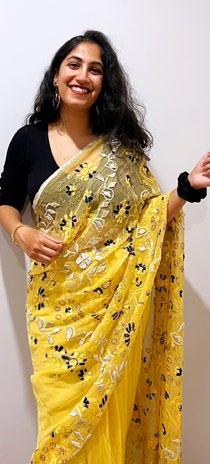
Manan Luthra
I like this red and white number from my mum’s saris. She wore it to my Year 12 end-of-year dinner, and was the only woman in a sari on the night. She looked resplendent. My photo with her and dad from that occasion, sits on my desk and I see it every day. Happy Mother’s Day, Mum.
Kaanchana Sekaran Karishama Singh
The pleats of this sari tell the many stories of my mum and her magic. Growing up, I saw her light up rooms with how she carried herself, and now I get to share this shine by wearing her saris. Of course, I also love adding my own touch to how I wear the tales of this fabric. The sari is more than mere metres of material; when we wear one, we actually don the chronicles of the many generations of women before us, allowing their legacy to live on. There have been many times Mum has raised an eyebrow at my tastes in style, but the few moments I see the sparkle in her eyes is when I’m clad in one of her saris. Our bond will remain timeless. Just like this sari.
I her the love some design; but friend’s how saris
Sunraj Patel Lily Gabriel
Honestly, I never ever thought I’d be into saris. Decided on a whim one day that I’d like to wear one, for no special reason. Mum was thrilled to bits. (And a bit disappointed I think, that I didn’t pick from her glam collection or her silk favourites!)
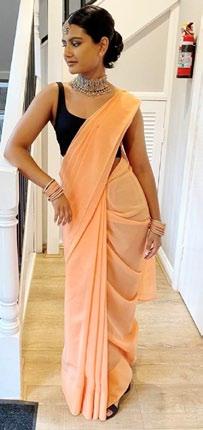
Anyway, she put this one on me as I stood unmoving, while she flitted around me like a butterfly. Then she added accessories and did some make up…. and I felt like a star! Can you tell I was in shorts about an hour before this shot was taken?
Mum recently wore this sari at a wedding. She looked striking. I think blue is her colour. I’d like to buy her another blue sari one day. Soon! Happy Mother’s Day, Mum.
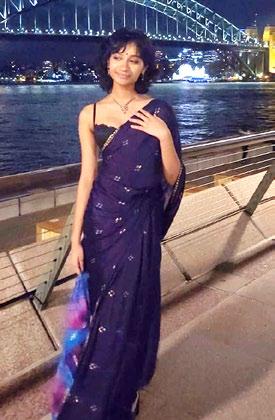
My mum is obsessed with saris. Everywhere she goes, she buy one! I love her saris too. I’m wearing her saris - simple elegant. I was to have her for me when in India recently. Thank you, Mum. everything.
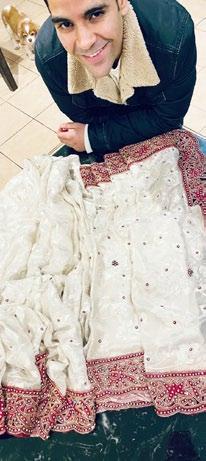
Radha Singh
watched one night as Mum looked through saris, trying to pick one to wear for an event the next day. I spotted this lilac one and fell in love with the colour. I asked if I could wear it some day. She said, “It’s a very old sari, in an old design; look at the new ones I have.” I looked, came back to this one. She tied it on me for a friend’s wedding weeks later. She was amazed at how nice it looked. Mum always picks the nicest saris – I know where I’ll be going when I want to wear a sari next.
Torsha Sen
Since childhood, I have been fascinated by the sari. I used to watch Mum expertly drape hers - it left me in awe. I’d use a dupatta and drape my own make-believe sari. Mum and I now share a collection of traditional Indian weaves from various parts of the country. And I still feel the same excitement as I did when I was young, every time I get to don the six yards. I am grateful to have inherited not just my mother's collection but also her grace and skill in carrying the sari.
Radhika Bhatia
The sari in this pic, the first sari I ever wore, is one of my mother’s favourites. I had no idea how to wear it but with help from Mum and about ten safety pins, we got it on. The material is quite delicate, and I was terrified of ripping it. But it was so lovely to be able to share this (and hopefully many other saris) with her.
Priya Arora
It was my first major social event after my recent wedding, and I wanted to make a splash. Raided Mum’s wardrobe, and picked this one. It’s a heavy sari and I’ve only seen her wear it once. Turns out, it was what she wore for her engagement, more than thirty years ago! It still retains its shine. Made me feel special as soon as I draped it. Thank you, Mum, it was an absolute honour. I love you.
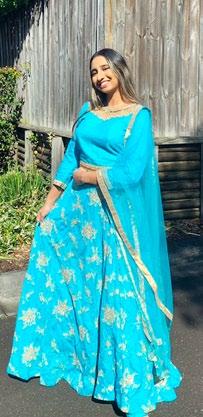
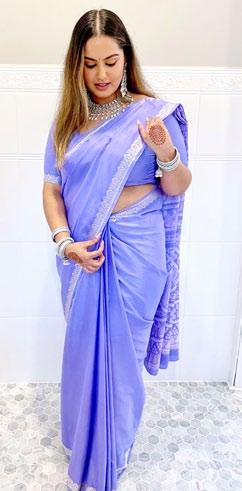
Suhayla Sharif
Gabriel obsessed Everywhere she has to love buying too. Here wearing one of simple yet was lucky drape it when I was recently. Mum. For everything.
Mehak Sikka Bhatnagar
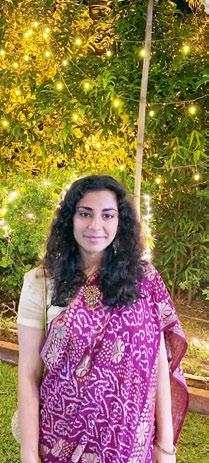
My love for Bollywood (and for saris) makes this one my favourite from my Mum’s (extensive!) collection of saris. Each time she wore it, I saw in her a Bollywood star. I wasn’t surprised at all when she presented it to me. But when I wore it, I realised it is her own charismatic charm, personality, and warmth that reflects in the yellow/gold of the sari. Happy Mother’s Day to you, Mum –my hero, my bestie.
Parina Johar
My mum’s all about beauty, grace and intelligence. You can tell, can’t you, by the way she’s draped her sari on me in this pic!
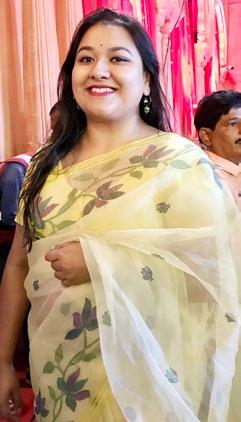
I hope her sense of style - and her careful way of doing thingspasses on to me.
On many Bollywood movie nights, Mum and I find ourselves sitting and simply studying the fashion, like we are reporters at the MET Gala. At these moments I can safely say I am my mum’s daughter, and I have never been prouder to be. This is a lehenga that I couldn’t wait to get my hands on from the moment Mum stepped out in it. Even though I feel like a princess with just the privilege of wearing it, I know I could never compare to the queen she is when she chooses to grace the world in this future heirloom.









